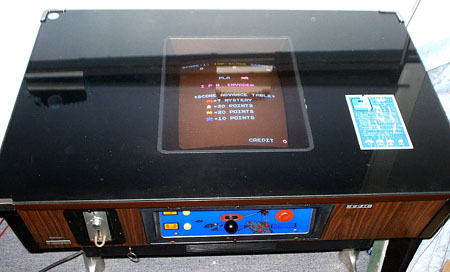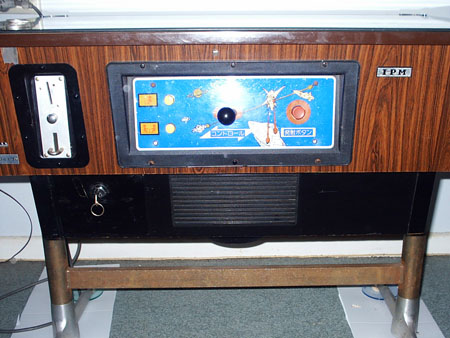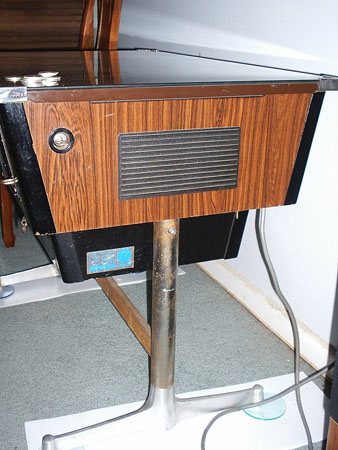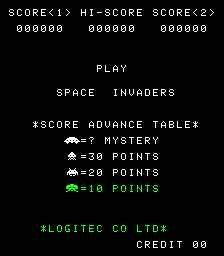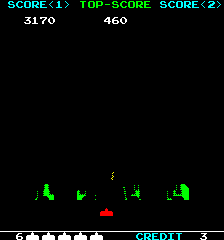The purpose of this site is to document as much information on the little known Space Invaders clone, IPM Invader. For those who are not aware of
IPM Invader, it is the game that has a 'coffee break' after every 3
waves of invaders. This has always fascinated me and I enjoyed reaching
the 'coffee break' when I was young. |
|||||||||||||||
|
|||||||||||||||
After many hours of researching, I found there to be hardly any information on the little known IPM Invader. (In the bibliography and links page I have linked every page I could find). This site will:
Manufacturer Two Japanese sites, (here & here), claim there were IPM Invader Part I,II,III. Whether this is true of not cannot be verified for lack of information. Theories suggest these may have been software revisions or more likely dip switch settings. (Dip switch settings and more will be discussed in detail in 'Technical Data' section). IPM Invader Part II,III and/or Capsule Invader may have been mistaken for being different games when it was more likely just IPM Invader with the dip switch settings changed. (More on this in 'Unique' section). ˜Date of Manufacture Date of manufacture on most information sites state 1979 as the production date. A minority states that 1978 was the production date while others just put unknown.
Below is a reply from John of Arcade 80's who is an operator in South East Queensland, Australia. Here's what he had to say on the subject: "Basically
this board was bought into Australia by a company called Vision Electronics
(circa 1979). It is widely known as the 'poor mans' version of Space
Invaders. Some 500+ pcbs of this version were bought into the country.
While Leisure and Allied were still making big dollars on the Taito
version [of Space Invaders] which was strictly licensed to
LAI. Vision Electronics found a source through a company called Irem.
Irem manufactured a copy pcb. With legal threats from its Japanese counterpart
[Taito] the company [Irem] redesigned the original
pcb into the 'IPM Invader' version. I'd hardly call it the 'poor mans' version as it is a great clone of Space Invaders. With added unique features like the 'coffee break' and the capsules make this an extension of an already great game; definitely NOT a poorer version of it.
IPM Invader users a colour monitor, unlike others which were using B&W monitors with colour overlays. Here where it gets a little fuzzy. Some claim that in Irem manufacturing IPM Invaders in 1978-79, that it was the first to make a Space Invader type game with a colour CRT or monitor. It would be in 1980 that Taito came to the table with Space Invaders Part II which had a colour monitor. In addition, according to KLOV, this game [Space Invaders Part II] was released in America by Midway as Space Invaders Deluxe. "Deluxe" used a color overlay however, instead of a color monitor. According to KLOV, in 1978 a company
called Logitec Co. LTD, manufactured a bootleg Space
Invaders (Logitec) with a colour monitor. While most of the screen
remains B&W, the green is actually generated by the PCB (Printed
Circuit Board) and although it looks very much like an overlay it's
not. So the question remains who had colour first? The answer would have to be Logitec Co. LTD, as it is more commonly known to be manufactured in 1978 as apposed to IPM Invaders 1978-79.
The reason that this variation of Space Invaders is unique, is that it has the famous 'coffee break' which no other has. What's the 'coffee break'? The 'coffee break' is a unique feature in IPM Invaders whereas after every 3rd wave or pattern of invaders, the 'coffee break' appears. Refer to the picture below for an example.
Basically, it is a rest in game play from the monotonous and repetitive onslaught from waves of invaders. Much like the challenging stage in Galaga breaks the game up. Or in Pac-man when after the second frame, a short respite is had with Pac-man being chased by the ghost across the screen only to have him grow larger and chase them back across the screen in the opposite direction. Another unique
feature in IPM Invader is the 'capsules'. When dip switch settings are
changed to advanced settings, the game becomes more difficult with the
introduction of the UFO (mystery score ship) dropping 'capsules' that
hatch into new invaders. The 'capsules' cannot be destroyed until they
hatch, and are dropped across the screen to defeat the players 'narrow
column' strategy. The 'coffee break' picture above shows the UFO dropping
'capsules'. IPM Invader is also a Dual sync game meaning it has separate Horizontal and Vertical outputs, and many have been modified to composite negative Horizontal sync because they won't work on most monitors.
|
||||||
|
|
||||||
|
All trademarks and
copyrighted materials are property of their respective owners. 2003-2018.© Last updated 12 July 2018. Maintained by The
Pinny Parlour |
||||||



